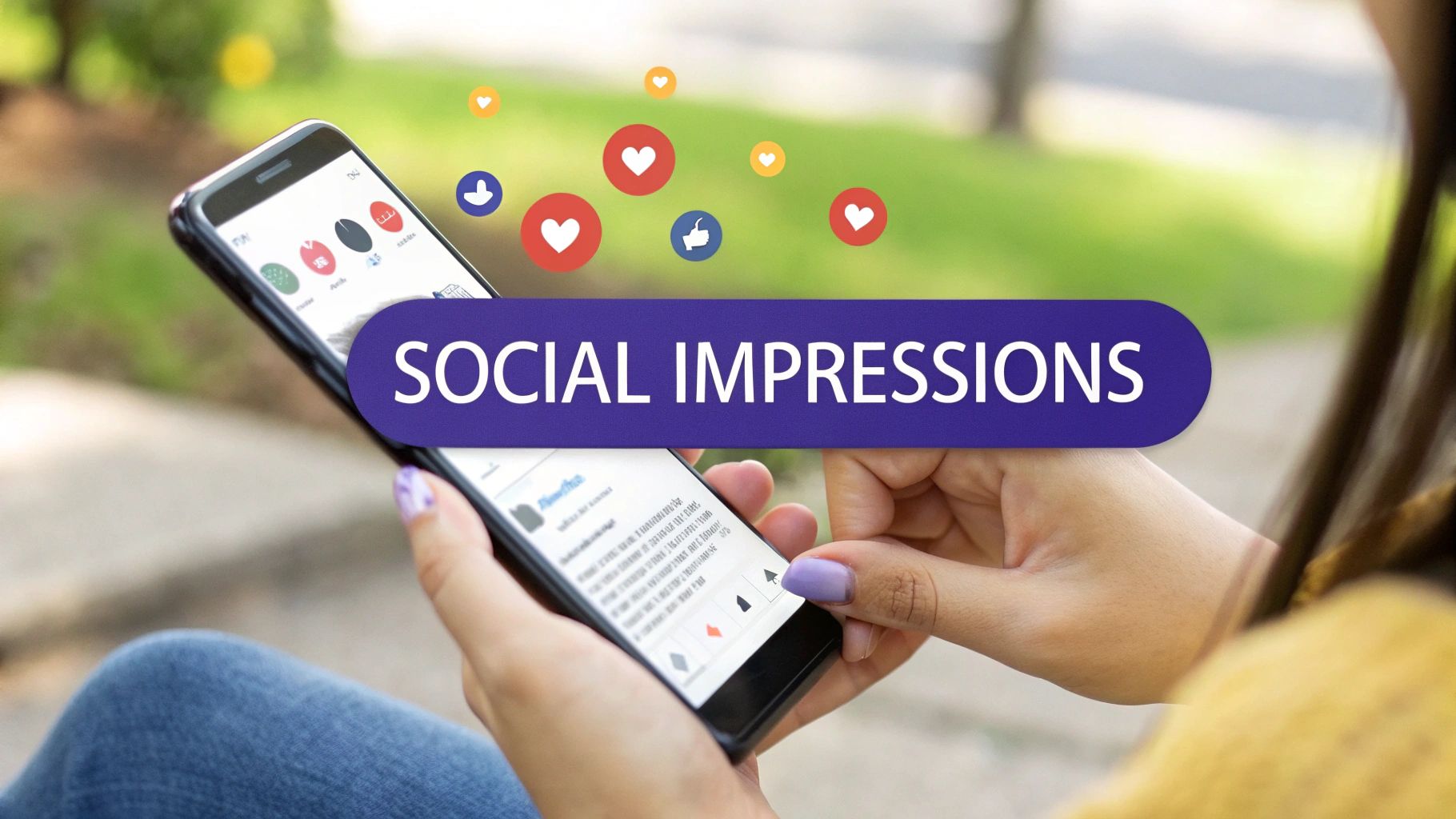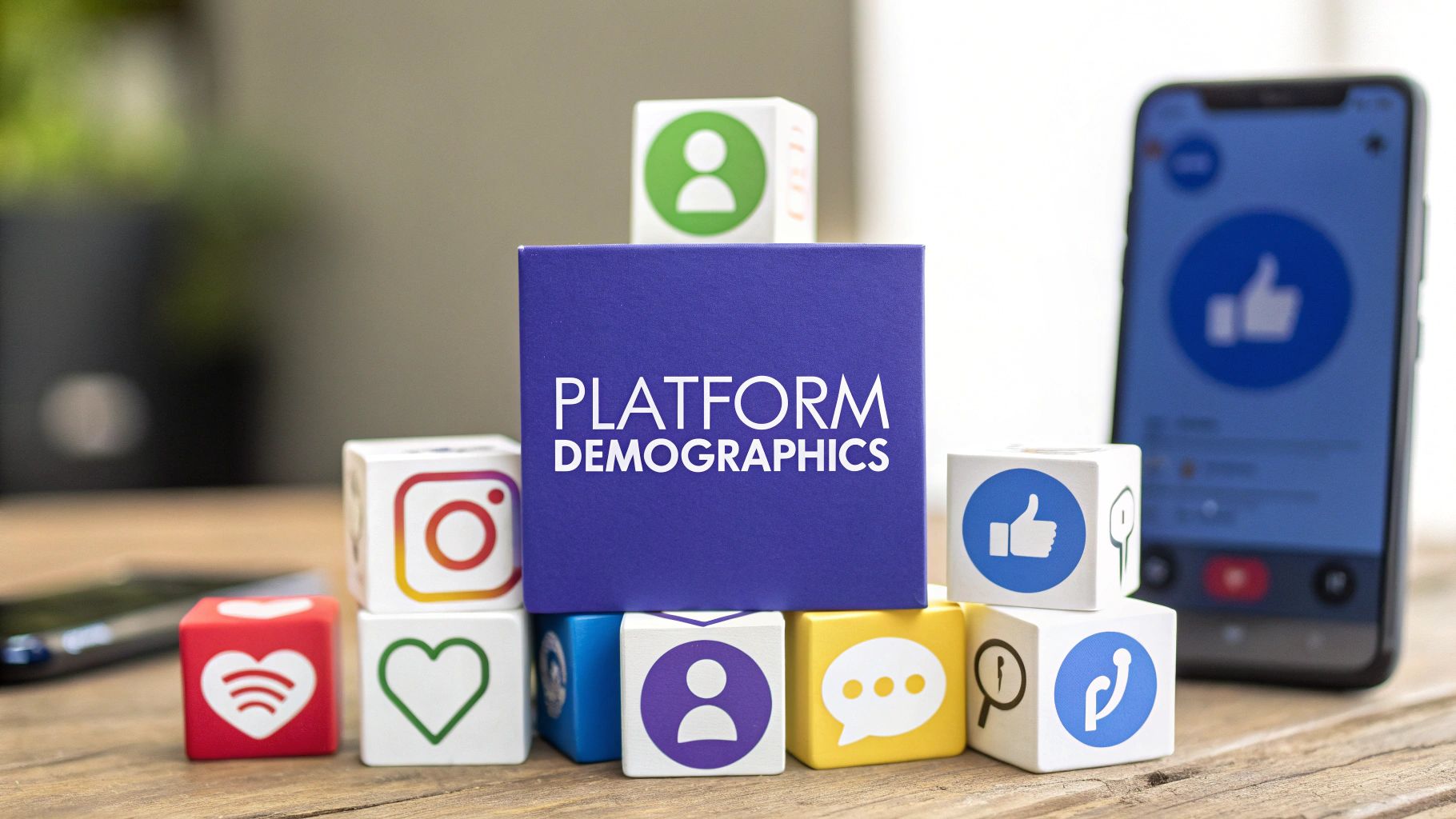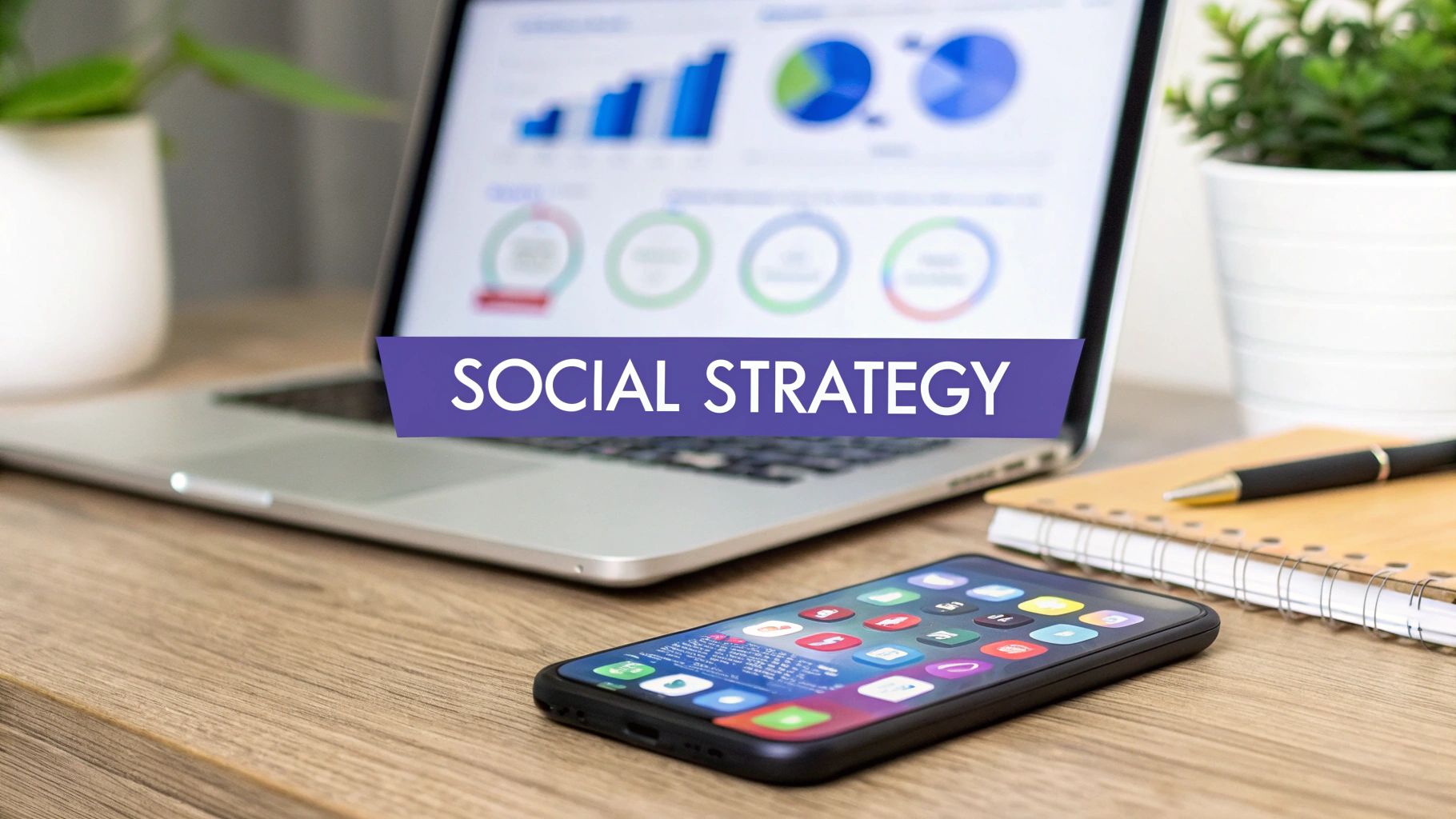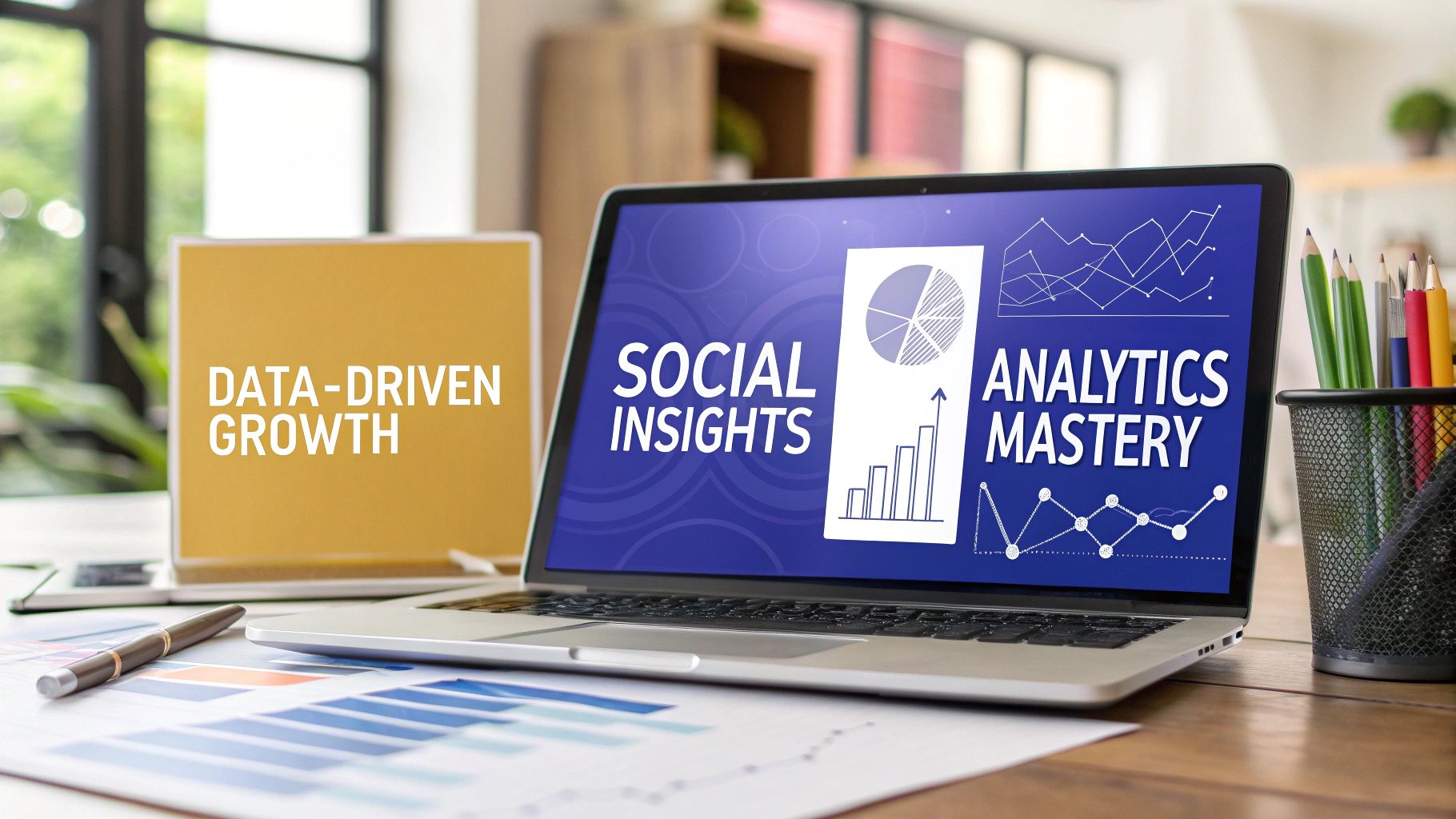Social media impressions are simply the total number of times your content gets displayed on a screen. That’s it. It doesn’t matter if anyone clicked, lingered, or even noticed it.
Think of it like a billboard on a busy highway. One person might drive past that billboard five times in a week. That’s one person, but five impressions. It’s the most fundamental metric for measuring how visible your brand is online.
What Social Media Impressions Actually Mean

Let's cut through the marketing jargon. At its core, a social media impression is a single instance of your content appearing in someone’s feed. They could scroll right past it without a second thought, but if it loaded on their screen, it counts.
Imagine you share a great new photo on Instagram. Every single time that photo shows up—whether in a follower’s main feed, on the Explore page, or through a hashtag search—that’s one impression. If your biggest fan sees that same post three separate times during the day, that one person just gave you three impressions.
The First Step in the Customer Journey
Before a single person can like, comment, or share your content, they have to see it first. This is why impressions are the foundational layer of your entire social media funnel. They're the first, most basic signal of brand awareness.
Without impressions, all those other flashy metrics simply can't exist. This simple count is a big deal for a few reasons:
- Content Visibility: It gives you a pulse on how well the platform's algorithm is distributing your content.
- Brand Awareness: High impression numbers are a good sign that your brand is getting exposure and staying top-of-mind.
- Campaign Health: It's the first place you should look to figure out why a campaign might be falling flat.
An impression is the digital equivalent of someone walking past your storefront. They might not come inside, but they know you're there. It's that first spark of recognition in a very crowded marketplace.
Getting a handle on this metric is crucial, but it’s often confused with others. For a great platform-specific breakdown, this article on what impressions mean on Pinterest shows how they fuel growth there. Getting clear on these terms is the key to building a strategy that actually works.
Key Social Media Metrics at a Glance
To really understand the power of impressions, it helps to see how they stack up against other common metrics like reach and engagement. Each one tells a different, vital part of your performance story. Think of them as different lenses for viewing your success.
Here's a quick comparison to clear things up.
| Metric | What It Measures | Analogy |
|---|---|---|
| Impressions | The total number of times your content was displayed. | The total number of times a billboard was seen by drivers. |
| Reach | The number of unique people who saw your content. | The total number of unique drivers who saw the billboard. |
| Engagement | The number of interactions (likes, comments, shares). | The number of drivers who called the number on the billboard. |
This table lays it all out. While reach tells you how many unique people you connected with, impressions show you the frequency of that connection. You need both to get the full picture of just how visible you really are.
Decoding Impressions, Reach, and Engagement
While impressions are a great starting point, they don't tell the whole story on their own. To really get a handle on your social media performance, you have to look at them alongside two other crucial metrics: reach and engagement. Think of these three as a team—they work together to give you a complete picture of your content's visibility and, more importantly, its impact.
Let’s put this into a real-world context. Imagine you're a food blogger and you post a new recipe video.
A follower sees it on their feed first thing in the morning. A few hours later, they see it again because a friend shared it. Then, that evening, it pops up on their Explore page. That’s one person (reach of 1) who has generated three impressions. This distinction is absolutely vital for figuring out what’s working with your campaigns and what isn’t.
This simple graphic helps visualize how these core metrics connect.

As you can see, impressions are the foundation. You can't have reach or engagement without them. Every unique person you reach adds to your total impressions, and every single interaction—a like, a comment, a share—all started with an impression.
The Interplay Between Impressions and Reach
Impressions and reach are closely related, but the ratio between them tells a fascinating story. Just to recap: reach is the number of unique people who saw your content, while impressions count the total number of views, including when the same person sees it multiple times. A healthy strategy often means your impression count is much higher than your reach, which shows your content is getting repeat exposure to your audience.
But this ratio can also be a red flag. If your impressions are sky-high but your reach is low, you might be dealing with ad fatigue. This is what happens when the same small group of people sees your post over and over again. Eventually, they just start to tune it out. Your message gets lost, and engagement almost always takes a nosedive.
From Views to Value: Adding Engagement
This is where the magic happens. Engagement is what turns a simple view into a meaningful action. It’s every like, comment, share, and save your post gets. If you have high reach but low engagement, it’s a sign that people are seeing your content but not connecting with it. Maybe the headline was a bit flat, or the image didn't have enough stopping power to make them pause their scroll.
Impressions open the door, but engagement is what invites your audience inside for a conversation. It's the difference between someone walking past your store and someone coming in to browse.
Nailing this is critical, especially when you consider how crowded social media is. By mid-2025, there were an estimated 5.41 billion social media user identities globally—that's 65.7% of the world's population. With so much competition for eyeballs, every single impression is an opportunity you can't afford to waste.
Going Beyond Likes and Comments
To truly understand performance, you need to look at the entire customer journey. Impressions build awareness, and basic engagement metrics (likes and comments) show interest. But what happens next? This is where you start measuring intent.
Beyond impressions and reach, you have to understand metrics like the Click-Through Rate (CTR). CTR tells you how many of the people who saw your post actually clicked the link inside it. This metric is the bridge between visibility and conversion, telling you if your content is actually compelling enough to drive traffic to your website or a specific landing page.
When you analyze all these metrics together, you get a powerful, multi-dimensional view of what's really going on. For a deeper dive, check out our guide to the most important social media engagement metrics.
Why Impressions Are Your Secret Weapon for Growth

It’s tempting to write off social media impressions as just another vanity metric. You know, a big number that pads your reports but doesn't actually mean anything for your bottom line. But if you see them that way, you're missing out on one of the most powerful tools in your growth arsenal.
When you know how to read them, impressions stop being a simple view count and become a powerful diagnostic tool that can shape your entire strategy.
Think of it like this: impressions are the very first domino in a long chain reaction. Before anyone can click, follow, or buy, they have to see your content first. Impressions are the raw, unfiltered measure of that initial visibility. They tell you if your message even has a fighting chance in an incredibly noisy world.
The Leading Indicator of Brand Awareness
Your impression count is the earliest warning sign you have for your brand’s health online. If impressions suddenly tank, you know something’s wrong long before your engagement or follower numbers start to dip.
On the flip side, a steady climb in impressions is a clear signal that the platform's algorithm likes what you're doing and is showing your content to more and more people. This gives you a real-time pulse on your performance.
For example, you post a video and it gets double your average impressions. Boom. You've just found a content format that the algorithm is rewarding. Ignoring that signal is like leaving money on the table. If you want to dive deeper, check out these powerful social media growth strategies you can start using today.
Impressions are your content's audition. They measure how many times you got on stage in front of an audience. Without a strong audition, you'll never get the chance to win them over with your performance.
The sheer scale of the audience makes this first step absolutely crucial. By 2025, there will be an estimated 5.45 billion social media users worldwide. The average person spends over two hours a day hopping between seven different apps. In that kind of environment, just getting seen is a massive win—and impressions are the scorecard.
A Powerful Tool for A/B Testing
So, how can you use this in a practical way? A/B testing. Impressions give you immediate feedback, which is perfect for figuring out what stops the scroll. You don't have to wait for clicks or conversions to know what’s working.
Let’s imagine a simple scenario:
- Ad Creative A: A clean product shot with bright, bold colors.
- Ad Creative B: A lifestyle photo of someone actually using the product.
You run both ads with the same budget and audience. Within a few hours, you notice Ad Creative A has generated 50% more impressions than Ad Creative B. That’s the algorithm telling you it finds the first ad more compelling and is pushing it to more people. With that early data, you can kill the loser and put your entire budget behind the winner. Simple.
This isn’t just for paid ads, either. You can apply the same logic to your organic content to test different:
- Post formats: Carousels vs. single images.
- Video hooks: Starting with a question vs. a bold statement.
- Headlines: Using emojis vs. keeping it text-only.
By keeping a close eye on your social media impressions, you can quickly refine your content strategy based on what the algorithm—and your audience—responds to instantly. This constant loop of testing and optimizing is the real secret to getting massive organic distribution and running campaigns that actually work.
Proven Strategies to Increase Your Impressions

Alright, you get what impressions are and why they're a big deal. Now for the fun part: making them grow. Boosting your impressions isn't about crossing your fingers and hoping for the best. It's about having a smart, repeatable game plan that works with the algorithms, not against them.
These aren't just generic tips you've heard a thousand times. These are actionable tactics you can start using today to get your content the eyeballs it deserves. The goal isn't just to be seen, but to be seen by the right people—the ones who will actually care.
Pinpoint Your Optimal Posting Times
One of the fastest ways to score more impressions is to post when your audience is actually scrolling. Dropping a post at 2 AM when your followers are asleep is like hosting a party when everyone's at work. You're just talking to an empty room.
Every audience is different. A B2B crowd might be glued to LinkedIn during the 9-to-5 grind, while a younger audience might be all over TikTok on weeknights. This is where a tool like PostSyncer becomes a lifesaver. It digs into your audience data and schedules your posts for those golden windows, taking all the guesswork out of it.
Why It Works: Social media algorithms love fresh content that gets immediate buzz. When you post at a peak time, you get a quick burst of likes and comments. This signals to the algorithm that your post is a winner and deserves to be shown to more people, sending your impressions soaring.
Master the Art of Hashtags and Trends
Think of hashtags as the road signs of social media. They guide people—and the platform's algorithm—directly to your content. Using them correctly is your ticket to reaching way beyond your current follower list. But just tossing in a bunch of random tags won't get you anywhere.
You need a balanced strategy. Try mixing broad, high-traffic tags with super-specific, niche ones. For instance, a local bakery might use:
- Broad:
#dessert(millions of posts, wide net) - Niche:
#sourdoughbread(more targeted, for the enthusiasts) - Local:
#austinbakery(perfect for attracting nearby customers)
Jumping on trending topics or challenges can also give you a massive, short-term impression boost. The trick is to make sure it feels natural for your brand. If you have to force it, it'll come across as awkward and your audience will see right through it.
Create Irresistibly Shareable Content
The holy grail of impressions? Getting your audience to do the heavy lifting for you. When someone shares your post, they're basically giving you a free ad to their entire network. That's how you get exponential growth. But what makes someone hit that share button?
Usually, it comes down to content that's incredibly valuable, genuinely emotional, or just plain relatable. Some formats are just naturally built to be shared.
High-Impact Content Formats:
- Short-Form Video: Content on platforms like TikTok and Instagram Reels is designed for virality. A short, snappy video with a trending sound can blow up overnight.
- Infographics: These are visual gold. They take complicated info and make it simple and pretty. People love sharing data-rich infographics because it makes them look smart.
- User-Generated Content (UGC): Sharing posts from your own customers is a massive trust signal. It not only builds community but also encourages others to post about you, creating a powerful cycle of free promotion and impressions.
- Contests and Giveaways: Nothing gets people sharing faster than the chance to win free stuff. A simple giveaway that asks users to like, follow, and share can skyrocket your impressions in just a few days.
When you focus on these strategies, you stop passively waiting for views and start actively creating them. Each tactic taps into what makes social media tick—timing, discovery, and community—to systematically build your impressions and set your brand up for real growth.
Measure and Optimize Impressions with PostSyncer
Knowing what social media impressions are is one thing. Actually tracking and improving them is a whole different ballgame. Trying to juggle analytics across five different platforms feels messy and overwhelming, leaving you drowning in data but starved for actual insights. That’s exactly why a centralized tool isn’t just a nice-to-have—it’s essential for turning chaotic numbers into a clear roadmap for growth.
PostSyncer completely changes how you look at your analytics. Instead of logging into a handful of different apps trying to stitch together a performance report, our platform pulls all your key metrics into one clean, unified dashboard. This lets you monitor impression trends, figure out what’s going wrong, and spot opportunities with speed and precision.
Your Central Hub for Impression Analytics
The real magic of analytics is in the context. A raw impression count doesn’t tell you much on its own. To get the full story, you need to see how it connects to other vital metrics like reach, engagement, and click-through rates. PostSyncer’s dashboard is designed to give you that holistic view without any of the usual headaches.
This integrated approach helps you answer the kind of critical questions that actually drive your strategy:
- Performance Dips: Why did last Tuesday’s post get so few impressions compared to the week before?
- Viral Spikes: What was it about that one video that made it get ten times the normal views?
- Audience Behavior: Are we getting more impressions in the morning or evening with our target audience?
Here’s a quick look at how PostSyncer visualizes your performance data, making complex trends dead simple to understand.
Right away, the dashboard shows you which content is killing it and gives you a clear overview of how your impressions are growing over time. It’s all about helping you figure out what your audience truly connects with.
Turning Data into Actionable Insights
With PostSyncer, you’re not just watching numbers on a screen; you’re actively finding ways to get better. Imagine you notice that your carousel posts consistently pull in 30% more impressions than your single-image posts. Boom. That's a powerful, data-backed insight you can immediately use to tweak your content calendar.
The platform makes it easy to compare performance across different campaigns or time periods. You can filter by content type, social channel, or specific campaigns to really drill down into what’s driving your visibility. For a deeper dive into building out your command center, check out our complete guide on setting up effective social media analytics dashboards.
PostSyncer doesn't just show you data; it helps you ask the right questions. It turns you from a data collector into a data-driven strategist who makes decisions with confidence.
That strategic edge is more important than ever. As the digital world gets bigger, so does the fight for attention. The number of active social media users is expected to hit a staggering 5.24 billion in 2025—a huge jump from just 2.08 billion a decade ago, according to Backlinko. With more people online than ever, having a tool that helps you cut through the noise isn't just helpful—it’s a necessity.
Diagnosing Problems and Spotting Opportunities
Let's say you launch a new ad campaign and the impressions are disappointingly low. Instead of just guessing why, PostSyncer lets you investigate like a detective. You can compare the new ad’s performance against past successful campaigns, looking at everything from the creative and copy to the audience targeting.
Maybe you’ll find the new ad has a lower impression-to-reach ratio, hinting that ad fatigue is setting in with that particular audience. Or perhaps you’ll discover that your video content on Thursdays consistently knocks it out of the park. These are the kinds of specific, actionable insights that lead to continuous improvement and help you squeeze the most impact out of every single post you publish.
Your Top Questions About Impressions, Answered
Let's be honest, navigating social media metrics can sometimes feel like you're trying to decipher a secret code. Even for those of us who live and breathe this stuff, social media impressions can bring up some tricky questions.
This last section is all about clearing up that confusion. We're going to tackle the most common head-scratchers and give you straight answers so you can use your data with confidence. Think of this as your personal cheat sheet for those "wait, what does that actually mean?" moments.
Are More Impressions Always Better?
Not really, and this is a big one. A massive impression count looks great on paper, but if it doesn't lead to anything meaningful, it's just a vanity metric. It's way more important to look at the quality of those views, not just the quantity.
Imagine your e-commerce brand runs an ad that gets 1 million impressions. Sounds amazing, right? But what if it leads to zero clicks and zero sales? Suddenly, that huge number doesn't mean much.
It would be far better to have a post with only 10,000 impressions that sends 100 people to your site to make a purchase. The smaller number delivered real, tangible results.
The goal isn't just to be seen; it's to be seen by the right people—the ones who will actually take action. When it comes to real business growth, quality impressions will beat sheer quantity every single time.
To get the full picture, you have to look at impressions alongside other key metrics. A high impression count is only powerful when it’s paired with a strong:
- Engagement Rate: Are people actually liking, commenting, or sharing?
- Click-Through Rate (CTR): Are those eyeballs turning into website visits?
- Conversion Rate: Are those visits leading to sales, sign-ups, or whatever your goal is?
When these numbers are also looking good, a high impression count is a sign of a truly successful campaign. If they’re low, it’s a red flag that your creative, message, or targeting needs another look.
How Do Different Platforms Count Impressions?
This is a huge source of confusion because, frankly, everyone does it a little differently. There’s no single, universal standard for what counts as an impression, so a "view" on one network isn't the same as a view on another.
For scroll-heavy feeds like Instagram and Facebook, an impression is typically counted the moment a post appears on a user's screen. It doesn't matter if they stop to read it or fly right past it in a split second. If it loaded in their feed, it’s one impression. The same goes for X (formerly Twitter)—if a Tweet is visible on someone's timeline, it's counted.
Video platforms, however, have their own set of rules.
- On YouTube, an impression is counted when at least 50% of a video's thumbnail is on screen for one second or more. A "view" is a completely separate metric that requires much more engagement.
- On TikTok, the platform counts a "video view" the instant a video starts playing. This is essentially their version of an impression when measuring performance.
Because of these differences, comparing your raw impression numbers across platforms is like comparing apples and oranges. It’s much smarter to focus on the performance trends within each individual platform.
What Is a Good Impression Count?
Ah, the million-dollar question. The honest answer? There's no magic number. What’s considered a "good" impression count is completely relative and depends on a bunch of factors specific to your brand.
Instead of chasing some arbitrary number you saw in an article, you'll get much further by benchmarking against your own performance. Aim for steady, consistent growth. A small local business with 500 loyal followers is going to have a very different idea of "good" than a global brand with millions.
Here's what influences a strong impression count for you:
- Audience Size: Your follower count is your starting point.
- Industry Niche: Some industries are just more visual and tend to pull in higher numbers.
- Content Quality: Great content gets rewarded by the algorithms and shown to more people. Simple as that.
- Platform: A viral TikTok might rack up millions of impressions, while a thoughtful LinkedIn article might hit a few thousand—and both could be considered a huge success.
A better way to measure this is by tracking your impression rate (total impressions divided by your follower count). A great goal to shoot for is having your impressions consistently exceed your follower count. This is a clear sign that your content is reaching beyond your immediate followers through shares, hashtags, and the algorithm. Focus on beating your own average, and you'll know you're headed in the right direction.
Ready to stop guessing and start making data-driven decisions? PostSyncer provides a centralized analytics dashboard that turns confusing numbers into clear, actionable insights. Track your impressions, understand your audience, and optimize your strategy all in one place. Start your free 7-day trial of PostSyncer today.















